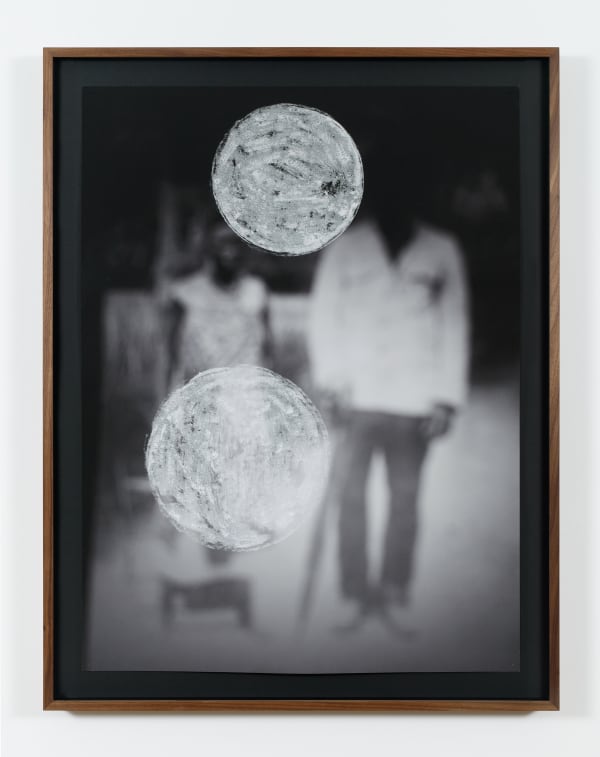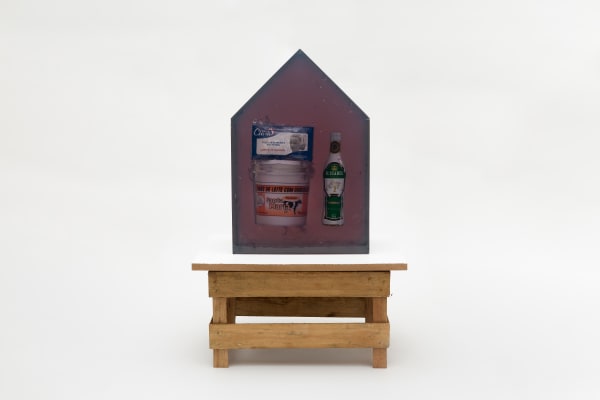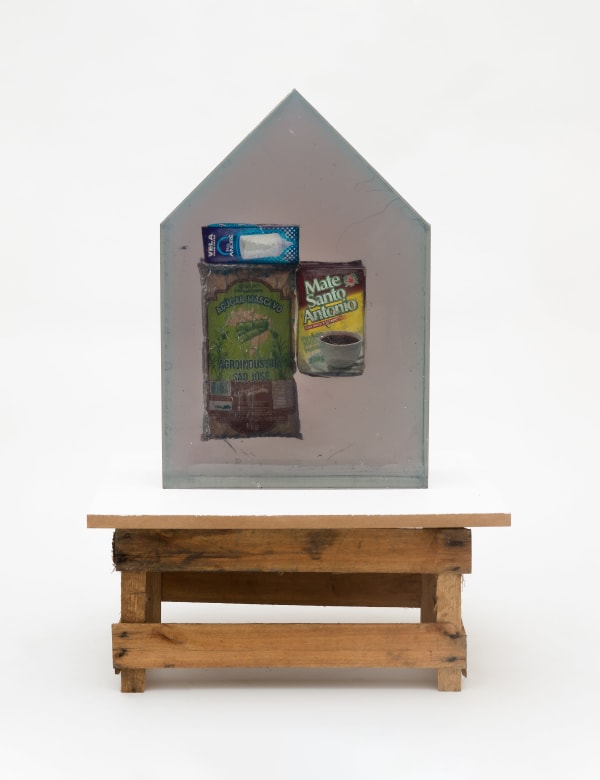[A] LA FLEUR DE LA PEAU Paulo Nazareth
Throughout the journey of Paulo Nazareth’s [A] LA FLEUR DE LA PEAU it is impossible not to evoke the abyss metaphor suggested by Martiniquais writer Édouard Glissant in Poetics of Relations. The image of the ship operates as a place of exile for Black bodies on the way to the unknown. The first abyss is experienced when entering the ship. The second is the sea crossing. Great Kalunga. The third abyss is the inverted image of glimpses of memory where new roots are laid through networks of learning. Rhizome. The shared knowledge of an experience of meandering exile, where every identity is extended through a relationship with the Other. Paulo Sérgio da Silva. Paulo da Silva. Sérgio da Silva. Ser da Silva. Paulo Nazareth. Nazareth Cassiano de Jesus. The Mother of his Mother. Ana Gonçalves da Silva. The Mother of his Sister. Ana Maria da Silva. The Grandmother, the Mother, The Sister and Motherhood. His Égun or Égúngún, for the Yorùbá people. Or, even, his Marét, for the Boruns, Indigenous people from Vale do Rio Doce. The ancestral spirit. Nazareth also becomes art materiality and immateriality. Transit between worlds. Transit between times. The act of travelling and handing out pamphlets reasserts the place of aesthetical conduct: expanded performance, generational event. Selling homemade soap made with chicken fat, sugar, lime, avocado, urucum. Distributing pamphlets-cards-leaflets for dentists, healthcare plans, Candomblé houses in Belo Horizonte (Minas Gerais). All work activities that the artist has performed in the past.
The journey introduces a self-ethnographic dimension where both autobiography and ethnography force us into a relationship of pertaining symmetry between Same versus the Other, Subjectivity versus Alterity, Individual versus Collective, Subject versus Object. Consequently, this generational event is mirrored in the act of walking performed by his mother Ana and sister Ana who go on a pilgrimage via emblematic routes as a metaphor for Mother Africa and the Diaspora. The route covers places such as the Musée de l'Homme (France) and the maximum-security prisons La Santé (France) and Saint-Gilles (Belgium). A ritual performance that combines aspects of the sacred and the profane when his mother Ana prays for the afflicted souls of genocide victims. The act condemns the colonial violence imposed by Belgian King Leopold II to secure the appropriation of the Congo. To the same extent, the pamphlets provide a sort of aesthetics of emergency in the artist’s own words: to burst open the headstone and cut the king’s throat with an arrow soaked in GOLDEN FROG poison. ----- with an arrow from the Pre-Columbian people EMBERA::: kill the king before he arrives in CONGO.
Within this performance context, we have the series Santos de Minha Mãe [My Mother’s Saints] made-up of food products inside resin blocks that feature the names of saints that safeguard requests for family protection and amulets to protect the body against danger. Nazareth also reclaims different forms of resistance used by enslaved people, such as Black brotherhoods and sisterhoods. Or even the Christianity of traditional street events such as Folias de Reis, Guarda de Congado and Moçambique in Minas Gerais. It refers both to a history of agricultural technologies linked to a colonial logic of commodities and the commercialisation of faith. His visual discourse presents art collecting as a critical practice. The processes of ordering objects evoke the collections of cabinets of curiosities that later became ethnographic museums, tangentially to values of aesthetics, art and science.
In the field of anthropology, the invention of photography anticipated its scientific use in studies on evolution, anthropometry and material culture. This led to the selection, classification and hierarchy of the cultural Other. Here we can cite the five daguerreotypes of a Borun woman and young man captured by E. Thiesson in Paris (1844), which belong to the Musée de l'Homme. The records of these dehumanised bodies that were exhibited under a mechanical gaze are confronted by his mother’s human gaze. This is not only Ana’s gaze; it is combined with Nazareth’s, re-signifying the place of science, annihilation and slavery in the re-elaboration of the subjectivity of these two people photographed, conjuring up a family history. The meaning of the exhibition becomes polysemic when connected to the voids and confrontations of the everyday experiences of hegemonized bodies.
The place of technology as politics of destruction and restitution of narratives is challenged in another series that uses black and white photography and printing on cotton paper to show images collected on the Internet. This materiality refers to agricultural technologies and social division of labour, as well as to cotton trading routes within a colonial history that entailed the transplantation of science from African people to the colonies during the Diaspora. The souls of anonymous people are captured at the same time these images are diluted by the fading of a collective social memory. It is a sort of shadow projecting an absence. Yet, it is one that paradoxically reveals a presence that is anterior to Ana and Nazareth. The photographic records are disrupted with white circles made of efun (a type of chalk used in Afro-Brazilian rituals). These circles are used in liturgical activities and refer to the re-establishment of balance by reclaiming a new voice for these hegemonized narratives.
In another work, Nazareth examines the political technology of bodies when he approaches the issue of the imprisonment of Black men in penal institutions. They are the drivers of the exercise of violence as a programmed and selective erasure of these selves. These relations appear in placards with the names of maximum-security prisons contrasting with the relationship between colonial powers and their colonies: La Santé (France), Saint-Gilles (Belgium), Kabare (Congo) and Île du Diable (French Guiana). Most importantly, the African prison is not a native institution, but a colonial remnant of body control. Crime becomes a tradable Black product. The experience of walking as an aesthetic form also appears in the performance (Mendes Wood DM Brussels, 24 April 2019) where the anonymous bodies of non-white immigrants perforate bags of flour and sweep the white powder into circles. The object of art is intertwined into the everyday life in the brutality of the white circle. Concrete geometric order. The daily ritual manifested in contemporary art. White circles associated to efun as a liturgy that re-organises a history interwoven with colonial violence and trauma.
Nazareth’s artistic propositions create a journey where aesthetic acts produce urgent epistemologies to invest against the marks of colonial cartographies. This appears in the duality of the circle that evokes the mathematical thought of Ancient African and 8th century Islamic geometry. The circle of African tradition contrasted to the rationality of Western art’s concrete art circle. Modernism. Post-Modernism. The performance and labour gesture of forming the circle. The political context of neoliberal capitalism that perpetuates inequalities.
The tensioning of these cartographies and the re-affirmation of community voices are re-elaborated in the dismantling of colonial traps through the use of technologies to control and intervene on individuals by articulating the planned annihilation of collectivity.
– Janaina Barros Silva Viana, visual artist, researcher and art critic, focusing on Brazilian contemporary art produced by Black artists.
-
 Paulo Nazareth, Untitled, from white ethnography series, 2019
Paulo Nazareth, Untitled, from white ethnography series, 2019 -
 Paulo Nazareth, Untitled, from white ethnography series, 2019
Paulo Nazareth, Untitled, from white ethnography series, 2019 -
 Paulo Nazareth, Untitled, from white ethnography series, 2019
Paulo Nazareth, Untitled, from white ethnography series, 2019 -
 Paulo Nazareth, Untitled, from white ethnography series, 2019
Paulo Nazareth, Untitled, from white ethnography series, 2019 -
 Paulo Nazareth, Île du Diable, 2019
Paulo Nazareth, Île du Diable, 2019 -
 Paulo Nazareth, Untitled, from white ethnography series, 2019
Paulo Nazareth, Untitled, from white ethnography series, 2019 -
 Paulo Nazareth, La Santé, 2019
Paulo Nazareth, La Santé, 2019 -
 Paulo Nazareth, Untitled, from white ethnography series, 2019
Paulo Nazareth, Untitled, from white ethnography series, 2019 -
 Paulo Nazareth, Untitled, from white ethnography series, 2019
Paulo Nazareth, Untitled, from white ethnography series, 2019 -
 Paulo Nazareth, Untitled, from white ethnography series, 2019
Paulo Nazareth, Untitled, from white ethnography series, 2019 -
 Paulo Nazareth, Untitled, from white ethnography series, 2019
Paulo Nazareth, Untitled, from white ethnography series, 2019 -
 Paulo Nazareth, Saint-Gilles, 2019
Paulo Nazareth, Saint-Gilles, 2019 -
 Paulo Nazareth, Santa Maria, São João, Santa Ana, 2019
Paulo Nazareth, Santa Maria, São João, Santa Ana, 2019 -
 Paulo Nazareth, São Domingos, Santa Clara, São Lourenço, 2019
Paulo Nazareth, São Domingos, Santa Clara, São Lourenço, 2019 -
 Paulo Nazareth, São Geraldo, São Lucas, 2019
Paulo Nazareth, São Geraldo, São Lucas, 2019 -
 Paulo Nazareth, San Lucas, Caacupe, São Ramão, 2019
Paulo Nazareth, San Lucas, Caacupe, São Ramão, 2019 -
 Paulo Nazareth, Santa Clara, Santa Maria, Santa Isabel, 2019
Paulo Nazareth, Santa Clara, Santa Maria, Santa Isabel, 2019 -
 Paulo Nazareth, Santa Rita, Santo Antônio, São Roque, 2019
Paulo Nazareth, Santa Rita, Santo Antônio, São Roque, 2019 -
 Paulo Nazareth, Santa Rita, Santo Antônio, São Roque, 2019
Paulo Nazareth, Santa Rita, Santo Antônio, São Roque, 2019 -
 Paulo Nazareth, São Jorge, Santa Luzia, Santo Antônio, 2019
Paulo Nazareth, São Jorge, Santa Luzia, Santo Antônio, 2019 -
 Paulo Nazareth, Santa Helena, San Antonio, San Lucas, San Martin, 2019
Paulo Nazareth, Santa Helena, San Antonio, San Lucas, San Martin, 2019 -
 Paulo Nazareth, Santo André, São José, Santo Antônio, 2019
Paulo Nazareth, Santo André, São José, Santo Antônio, 2019 -
 Paulo Nazareth, São Roque, Santa Amália, São Francisco, 2019
Paulo Nazareth, São Roque, Santa Amália, São Francisco, 2019 -
 Paulo Nazareth, São João, São Vítor, São José, 2019
Paulo Nazareth, São João, São Vítor, São José, 2019 -
 Paulo Nazareth, Iroko de Bom Jesus, 2017
Paulo Nazareth, Iroko de Bom Jesus, 2017 -
 Paulo Nazareth, Untitled, from white ethnography series, 2019
Paulo Nazareth, Untitled, from white ethnography series, 2019 -
 Paulo Nazareth, Kabare, 2019
Paulo Nazareth, Kabare, 2019 -
 Paulo Nazareth, Dupresso, 2016
Paulo Nazareth, Dupresso, 2016 -
 Paulo Nazareth, Terreiro, 2016
Paulo Nazareth, Terreiro, 2016 -
 Paulo Nazareth, Untitled, from white ethnography series, 2019
Paulo Nazareth, Untitled, from white ethnography series, 2019 -
 Paulo Nazareth, Untitled, from white ethnography series, 2019
Paulo Nazareth, Untitled, from white ethnography series, 2019 -
 Paulo Nazareth, Untitled, from white ethnography series, 2019
Paulo Nazareth, Untitled, from white ethnography series, 2019
![[A] LA FLEUR DE LA PEAU, Paulo Nazareth](https://artlogic-res.cloudinary.com/w_800,h_800,c_limit,f_auto,fl_lossy,q_auto,dpr_auto/ws-mendeswood/usr/images/exhibitions/group_images_override/62/mwdm_paulo-nazareth_exhibition_highres_043.jpg)































![Paulo Nazareth, [A] LA FLEUR DE LA PEAU, Mendes Wood DM Brussels](/lib/archimedes/images/shim.gif)
